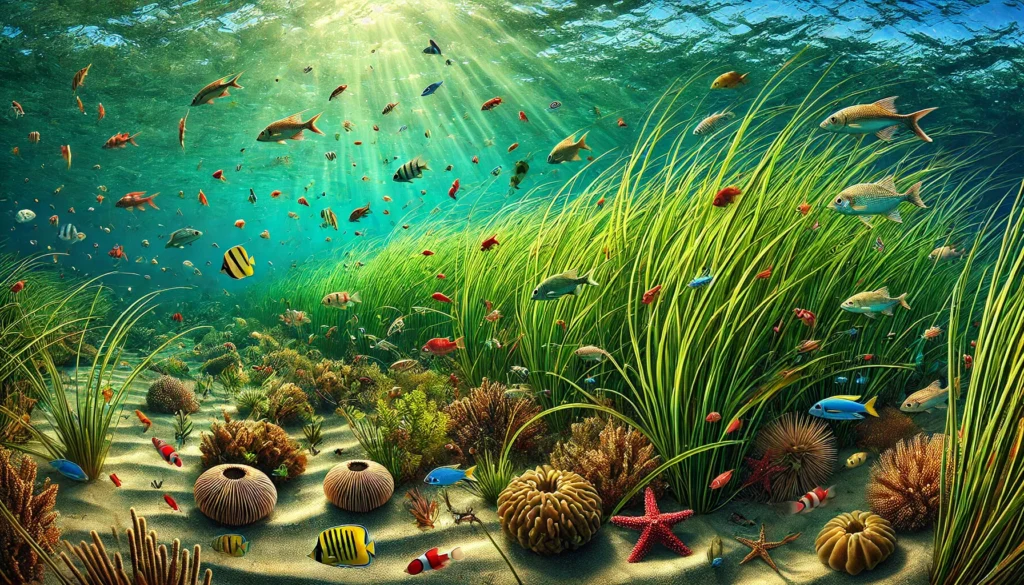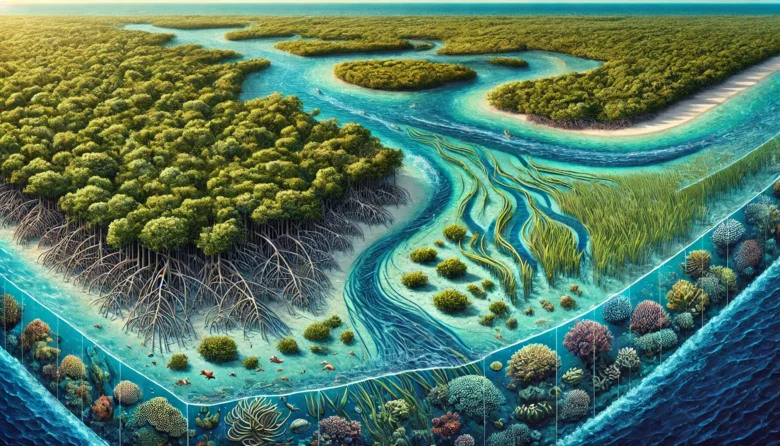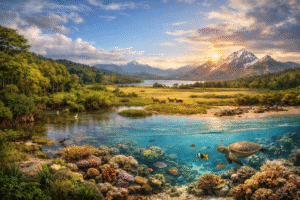Fun Fact: Did you know that marine ecosystems, such as coral reefs and seagrass beds, are capable of absorbing and storing more carbon per square meter than many terrestrial forests?
Covering more than 70% of the Earth’s surface, our oceans are far more than just expansive bodies of water. Beneath the waves, marine ecosystems play an enormous, often overlooked role in the fight against climate change. Marine ecosystems play a crucial role in capturing and storing carbon dioxide (CO2), a key greenhouse gas that drives global warming.
The Blue Carbon Powerhouse
When we talk about ecosystems that combat climate change, forests typically steal the spotlight. But there’s another type of carbon capture just as critical: blue carbon. Blue carbon refers to carbon stored in coastal and marine ecosystems. Mangroves, seagrass meadows, and salt marshes are the primary blue carbon ecosystems that pull CO2 from the atmosphere and store it in their biomass and sediments. What makes them especially important is their ability to capture carbon at rates much faster than terrestrial forests.
Mangroves: The Coastal Guardians
Mangroves are salt-tolerant trees that thrive along tropical coastlines. These remarkable trees act as natural barriers against storm surges and coastal erosion while also storing up to ten times more carbon than land-based forests. One case study from Bangladesh showed that mangrove restoration not only protected communities from flooding but also significantly boosted carbon storage. By restoring degraded mangrove forests, countries like Indonesia are making strides in combating climate change while protecting biodiversity.

Seagrass Meadows: The Underwater Carbon Vaults
Beneath shallow coastal waters, seagrass meadows act as critical nurseries for fish and other marine life. But what’s lesser known is their ability to trap carbon dioxide in the sediments beneath them. Seagrass ecosystems can store carbon for centuries, even millennia. In fact, despite covering only 0.1% of the ocean floor, seagrasses account for 10-18% of the ocean’s carbon storage. Seagrass restoration projects in places like the Mediterranean Sea have proven highly effective in increasing biodiversity and boosting blue carbon stores.
Coral Reefs: The Climate Buffer
Coral reefs, though often highlighted for their beauty and biodiversity, also play a role in fighting climate change. These colourful ecosystems act as natural wave breakers, protecting coastlines and reducing the energy of storm surges, which are becoming more intense due to global warming. While they don’t store as much carbon directly as mangroves or seagrasses, coral reefs protect marine life, which in turn contributes to carbon cycling within the ecosystem.
The Ocean as a Climate Regulator
The ocean does more than just store carbon in ecosystems like mangroves and seagrasses. It regulates global temperatures by absorbing about 90% of the heat generated by rising greenhouse gas emissions. Without this natural “climate buffer,” the world would be experiencing much hotter temperatures today. Unfortunately, this heat absorption has come at a cost—ocean temperatures are rising, leading to coral bleaching and threatening marine biodiversity.
A Case for Protecting Marine Ecosystems
While marine ecosystems are excellent at capturing carbon and mitigating climate change, they are also highly vulnerable to the effects of climate change. Rising sea levels, ocean acidification, and pollution are putting these natural carbon sinks at risk. For example, coral reefs are dying off at unprecedented rates due to warming ocean temperatures, which not only endangers marine life but also weakens the ocean’s ability to fight climate change.
But there’s hope! Countries and organizations around the world are stepping up their efforts to protect and restore these vital ecosystems. For example, the United Nations Environment Programme (UNEP) has launched initiatives like the “Blue Carbon Initiative,” which is focused on the protection and restoration of coastal and marine habitats. This global movement is backed by numerous case studies showing how investing in marine ecosystem restoration can yield benefits for both the environment and local communities.
How You Can Help: Everyday Actions
Now that we understand the power of marine ecosystems in combating climate change, what can we do to help?
Support sustainable seafood: Overfishing not only harms marine species but also disrupts the balance of marine ecosystems, affecting their ability to store carbon. Choose sustainably sourced seafood to reduce your environmental impact.
Reduce plastic waste: Ocean pollution is a massive threat to marine ecosystems. Simple steps like using reusable bags, avoiding single-use plastics, and participating in beach clean-ups can help protect these critical ecosystems.
Advocate for policy change: Policies that protect coastal ecosystems are essential. Support legislation that prioritizes marine conservation and holds polluters accountable for their impacts on the ocean.
Consider carbon offset programs: Many organizations offer blue carbon offset programs, where your contribution goes directly toward restoring mangroves, seagrasses, and other vital marine ecosystems.
Conclusion: The Ocean’s Call to Action
Marine ecosystems are unsung heroes in the fight against climate change. From the dense carbon-storing mangroves to the resilient coral reefs, these natural systems provide solutions that are as vast as the ocean itself. But they cannot do it alone—they need our protection, our respect, and our action. By recognizing the importance of these ecosystems and working to preserve them, we can help ensure the health of our planet for future generations.
So, the next time you enjoy a walk along the beach or a swim in the sea, remember that the ocean is more than just a place for relaxation—it’s a powerful ally in our global battle against climate change.
Author’s Note:
I’ve always been fascinated by the ocean and the incredible ecosystems it supports. As we face the challenges of climate change, it’s more important than ever to recognize and protect these vital ecosystems. Let’s do our part to ensure a sustainable future for both land and sea.
G.C., Ecosociosphere contributor.
References and Further Reading:
- National Geographic – How Seagrass is Helping to Fight Climate Change
- CGIAR Research Program on Climate Change, A. A. F. S. (2015). Climate-Smart Agriculture: What is it? Why is it needed? https://core.ac.uk/download/132667070.pdf
- Goumbook Launches MENA Oceans Network with United Nations UAE at COP28. https://goumbook.com/goumbook-launches-the-mena-oceans-network-in-partnership-with-united-nations-uae-at-cop28/
- Aapa Mire Wilderness Life. Southernmost aapa mire wilderness areas in Northern Ostrobothnia and Kainuu. Final report – julkaisut.metsa.fi. https://julkaisut.metsa.fi/fi/julkaisut/show/1517
- Which Is A Sustainable Practice? Operating Wind Farms Clear Cutting Flood Irrigation Overfishing. https://joinpdnow.com/which-is-a-sustainable-practice-operating-wind-farms-clear-cutting-flood-irrigation-overfishing/




